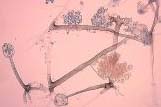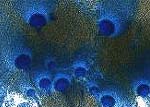
|

|
| Rhizopus mold. | Aspergillus mold. The "peacock" shaped structures are fruiting bodies with spores. |
| MadSci Network: Microbiology |
Ben,
This sounds like a very interesting science project, I hope you do well.
1. Calcium Propionate is a preservative. Its main function is to inhibit mold growth, is less effective against bacteria, and has no great effect on yeast. It is used in products with lower pH (a measure of acidity), typically fermented products like bread and cheese. In products with low water activity (a measure of how much water is available for microorganisms to grow) mold will be the way that it spoils. Bacteria and yeast require much more water to grow.
Potassium Bromate, on the other hand, is not a preservative. Bromate is called a dough conditioner. Chemically, it is called an oxidizing agent. In bread it has two main purposes:
For a long time it had been thought that all the potassium bromate was destroyed in the dough proofing and baking process. In the 1980's more sensitive chemical tests were developed. These tests are capable of measuring a few part per billion. As an example, the state of Louisiana is about 160 billion square yards in size. One room about 38 feet long on each side (probably about the size of your classroom) would be one part in a billion, where the entire state of Louisiana is the billion.
Although these small amounts have never been shown to cause cancer in people, some countries have banned its use. Some people who are very concerned about their health have chosen to not eat products that use bromate. That is why some companies advertise that their products are bromate free.
3. There are thousands of species of mold. Mold species are identified largely by their morphology, how they look and are put together. It takes someone with a very good knowledge of molds, skillful in the prepartion of slides, and with expertise in the use of microscopes to differentiate species of mold.

|

|
| Rhizopus mold. | Aspergillus mold. The "peacock" shaped structures are fruiting bodies with spores. |
I hope this information is useful to you.
Try the links in the MadSci Library for more information on Microbiology.